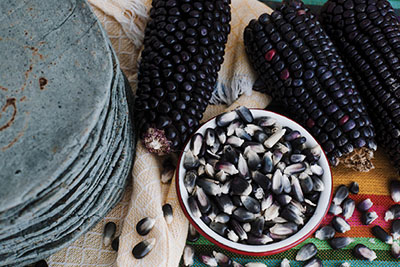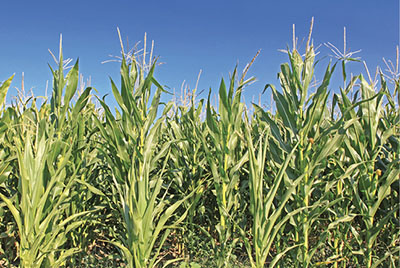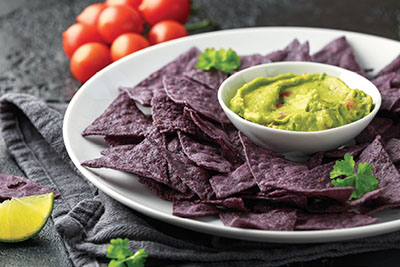Guide H-226
Revised by Lois Grant
College of Agricultural, Consumer and Environmental Sciences, New Mexico State University
Author: Research Associate Professor, Department of Plant and Environmental Sciences, New Mexico State University. (Print Friendly PDF)
Maize or corn has been the basis for many great cultures in the New World, including those of the Inca, Maya, and Aztec civilizations. Corn was domesticated in Mexico and cultivated by Native Americans in New Mexico by 4100 B.P. (before present). Corn has been a major staple of the Pueblo Tribes of the U.S. Southwest. In the past and present, corn is an important element in Native American religious rituals. Although Pueblo Tribes planted many different colors of corn, blue corn became one of the most important. It was generally dried on rooftops, stored as grain on the cobs, shelled, and ground into meal as needed.
Corn is a mainstay of modern American agriculture. Most of the corn crop is grown for animal feed and ethanol production, with only a small percentage grown for human consumption. Of that grown for food, yellow, white, and blue corn are used in cereal and cornmeal products, traditional foods, and snacks. Since corn contains no gluten, the demand for corn products has increased along with consumer demand for gluten-free products. Blue corn products are popular as “superfoods” because the anthocyanins responsible for the blue color are antioxidants that help remove free radicals and may contribute to overall human health.
© Marcos Castillo | Dreamstime.com
Blue Corn Nutrition
The protein content of blue corn is reported to be 8–20% higher than commercial hybrids. The higher protein levels are found in heirloom, or landrace, blue corn; the lower values are found in blue corn that has been selected for increased yield or cultivation under intensive agricultural practices. The oil content of blue corn follows the same pattern as protein content.
Starch content is lower in blue corn, and its starch digestibility differs from that of white and yellow corn. As a result, the glycemic index of blue corn is lower than other corn.
Kernel Characteristics
The kernel is made up of three parts: the embryo, endosperm, and seed coat. The white, starchy endosperm provides food to the germinating embryo and is the largest component. Most local blue corns have soft, or floury, endosperm covered by a thin, evenly distributed layer of hard, corneous endosperm. The outermost endosperm is typically a single layer of cells called the aleurone layer. A thin layer of crushed cells called the pericarp covers the entire kernel and serves as the seed coat. In blue corn, the anthocyanin pigments can be found in the pericarp and/or aleurone layer. The small blue aleurone cells can be in multiple layers, or become so dense that kernels appear black.
The shape of the kernel is highly variable with variety. Shape can range from small, flint-type kernels to large hominy types.
Plant Characteristics
Unlike most commercial hybrid dent corn that can yield 8,000–10,000 pounds of grain per acre (9,000–11,200 kg per hectare), blue corn is open-pollinated and is characterized by relatively low yields of 1,000–4,000 pounds per acre (1,100–4,480 kg per hectare). Most blue corn varieties exhibit highly variable plant characteristics, including long flowering periods, multiple ears, and uneven plant heights. Some blue corn has tall, multi-eared, single stalks; others may produce multiple tillers (lateral or side shoots) per plant. Stalks may have a tendency to fall over (lodge), and this makes machine harvesting more difficult than for hybrid dent corn. Many varieties occasionally produce blank plants that do not produce ears, especially if planted at high density.
© Baloncici | Dreamstime.com
Seed Choice
Most blue corn varieties are open-pollinated landraces. This means that they have traditionally been grown in a specific area and have adapted over time to the climate, altitude, and cultural conditions of that place. For best results, choose seed of a variety from an area that most closely resembles your own location.
At present, few hybrid blue corn varieties exist, and the few that do are proprietary and grown on contract for suppliers of blue corn to food manufacturers.
Seed may be sold as organic or conventional. If you plan to market blue corn as organic, it must be grown in organically certified fields and in accordance with the national organic standards; the seed should be organic, and it must be untreated (with fungicides or pesticides) and non-GMO. There is no GMO blue corn seed; however, seed can be contaminated. If you are growing corn to be sold as organic or non-GMO, the seed should be tested to ensure there has been no contamination.
Planting and Fertilization
Blue corn grows best in deep, well-drained, sandy loam soils with plenty of organic matter. Field preparation is the same as other types of corn (chiseling, plowing, disking, listing). Depending on soil type, seed should be planted 1–2 inches deep in pre-irrigated beds or watered up.
Yields will fluctuate greatly with plant spacing, fertility level, and the amount of water applied. Optimal yields can be achieved when native blue corn plants are 9 inches apart in the row on 36 inch centers under full irrigation. Nitrogen fertilizer should be applied in split applications, with 25–50 pounds per acre of elemental nitrogen applied before planting, and another 25–50 pounds applied as a side dressing when plants are 12–18 inches tall. Applications of more than 100 pounds of N per acre are unlikely to increase yield, and may increase lodging due to excessive plant height. Pre-plant phosphorus should be banded into the beds at a rate of 40–80 pounds of P2O5 per acre, if need is indicated by a soil test. Fields that have had previous applications of manure may already have high levels of P2O5.
Although potassium is rarely a limiting factor on most New Mexico soils, there are indications that supplemental potassium tends to reduce lodging. Growers might want to consider applying potassium at a rate of 50–100 pounds of K2O per acre, particularly if a soil analysis indicates low soil potassium levels. For more information on soil testing, see NMSU Extension Circular 676, Interpreting Soil Tests (pubs.nmsu.edu/_circulars/CR676).
For organically grown blue corn, raw manure is best applied in the fall at a rate of 20 tons per acre, but can be applied in the spring (up to 90 days before harvest). Composted manure may be applied in the spring at the same rate. Producers should avoid manure with high salt content. Blue corn also performs well following a rotation of deep-rooted legume crops like alfalfa that are turned under 2–3 months before planting. A good prior stand of alfalfa should provide sufficient N for an open-pollinated corn crop.
Pest Control
Pests of blue corn are the same as those of other field corns. Growers should consult their local county Cooperative Extension Service agent (https://aces.nmsu.edu/county/) for the latest recommendations on registered or OMRI approved pesticides for use on corn for grain (flour). Pesticide labels should be carefully followed for control of all weeds, insects, and diseases.
Blue corn differs from other corn in that it often has a longer flowering period. This can affect a corn earworm control program. One, two, or more applications of appropriate controls might be needed.
Birds can be a major pest of blue corn. Propane guns are often used to frighten birds from fields.
Blue Corn Improvement
Because most blue corn varieties are open-pollinated landraces that are not covered by intellectual property restrictions, growers can save seed for future planting. Open-pollinated varieties can be improved by selecting next year’s seed from superior plants in the field before harvest.
There are two phases in the selection process. The first selection takes place in the field. Harvest ears for seed only from plants with superior traits. When selecting ears in the field, growers should select only ears from plants that have not lodged. Depending on the amount of variability in the plant population, growers should also select ears from plants with few extra stems and ear placement at mid-plant height. Also look for tight husk leaves that extend beyond the tip of the ear and ears that flop over or hang down after drying on the plant. Plants with tight husks tend to have less insect and disease damage, and ears that hang down tend to have less water accumulation (which can lead to molding) and bird damage.
After shucking, the ears should undergo a second selection phase by discarding all ears with poor kernel traits or cob rot. Choose medium to large ears with dark blue kernels that shell easily. Only keep ears with minimal or no insect and disease damage. Small kernels tend to exhibit a higher-quality, nuttier blue corn type taste. The higher quantity of starchy (white) endosperm in larger seeded varieties also tends to dilute the blue color in the flour after processing. Some millers may want larger kernels, so communicate with buyers and end users to see what their preference may be. Ears with dented kernels should be rejected unless a harder kernel is needed to withstand mechanical harvest or the end user prefers a harder kernel.
Dried seed corn (below 13% moisture content) can be stored shelled or on the cob in a cool, dry area until the following spring. All cracked kernels and foreign debris should be removed from shelled corn before storage. If weevils are observed, small seed lots can be placed in a freezer for at least two days. Larger quantities may require insecticide treatment. Consult your local county Extension agent for recommendations.
Harvesting
Machine harvesting of blue corn generally begins when grain is around 20% moisture. Lower moisture levels generally result in more cracking of the kernels. Properly adjusted rotary combines are the preferred means of harvesting over picker-shellers because they result in fewer cracked kernels. After harvest, grain must be air dried to 13% moisture or below for safe storage.
Non-GMO and organic blue corn needs to be free of GMO corn. If GMO corn is grown near your field, pollen drift can occur. Harvesting border rows separately and keeping this corn separate until it can be tested can reduce the risk of contamination.
Marketing
Most blue corn is grown under contract. Large buyers often require the recleaned seed be free of disease, insect infestations, frost damage, extraneous matter, and other imperfections. The Federal Food, Drug, and Cosmetic Act requires the seed be free of unsafe chemical residues. Seed should be near 13% moisture with no more than 10% stress cracks. A good dark blue color is important, and off-type colors should not exceed levels of 2%. Most processors also require that the grain be delivered in new burlap or paper bags.
© Funandrejs | Dreamstime.com
Blue Corn Products
Blue corn has a coarser, sweeter, and nuttier taste than other types of flour corns. It is the basis for many traditional Native American foods.
Blue corn tortillas have traditionally been one of the most popular foods made from blue corn. Blue corn flour tends to have a coarser, grainier consistency than yellow or white corn flours, resulting in a somewhat denser tortilla.
Piki or paper bread is less well known than blue corn tortillas. Prepared from a thin batter of fine blue corn meal and boiling water, the resulting paste is spread on a hot, flat stone or metal griddle that has been oiled with crushed seeds of squash, sunflower, or watermelon. The wafer-thin cake that results is peeled off and folded or rolled like a newspaper.
Chaquegue is a gruel made from finely ground blue corn meal, and is similar to cornmeal mush. The kernels are toasted before being ground, giving the meal a slightly different flavor.
Atole de maiz is similar to chaquegue, but is a drink with a consistency more like cream. Aztecs and Mayas often added other ingredients like chile, honey, or chocolate. Each atole had a special name depending on its ingredients.
Hominy is made by a process called nixtamalization, which involves soaking dried kernels in heated limewater to remove the pericarp (hull) from the kernels. The limewater is an alkaline solution made by adding slaked lime (cal) or wood ash. Cal is available in many Hispanic grocery stores. This soaking process makes the corn more digestible and the nutrients more available. Hominy is the primary ingredient for stews and other dishes, such as posole. The soaked kernels can be washed and ground into dough called nixtamal. Nixtamal is used to make masa for tortillas and tamales.
Pinole is made up of a mixture of toasted blue corn meal and toasted acorns or other seeds. This lightweight, highly nutritious food can be used directly as food or mixed with water to drink. Sugar, honey, or other sweeteners are occasionally added to pinole to make a more palatable drink.
Chicos are corn in the soft dough stage that has been steamed in the husk and dried. Traditionally, a pit is dug in the ground and the soil heated by burning wood in it for 1–2 days. The fire is removed, and green ears in the husks are then placed in the pit and covered with soil. The partially roasted ears are removed, the husks stripped back, and the ears tied together in pairs and hung out to dry. The kernels were roasted to kill the grains and to help them dry faster to preserve their food value. Chicos are generally cooked with chile and green onions, or in stews.
Non-Traditional Blue Corn Products
Although the traditional blue corn tortilla will probably remain the backbone of the blue corn market, new products have expanded the uses of blue corn flour. These products include items like blue corn chips, pancakes, muffins, and corn flakes. Expansion of the blue corn industry depends on promotion of both traditional products and new products.
For Further Reading
H-168: Selection and Use of Insecticides for Organic Production
https://pubs.nmsu.edu/_h/H168/
H-223: Home and Market Garden Sweet Corn Production
https:pubs.nmsu.edu/_h/H223/
CR-676: Interpreting Soil Tests: Unlock the Secrets of Your Soil
https:pubs.nmsu.edu/_circulars/CR676/
Original author: George W. Dickerson, Extension Horticulture Specialist.

Lois Grant is a Research Associate Professor in the Department of Plant and Environmental Sciences at New Mexico State University. She earned her Ph.D. in agronomy from Purdue University. Her research focuses on Southwestern heritage varieties of corn and dry bean species as potential sources of drought and heat resistance in sustainable cropping systems.
To find more resources for your business, home, or family, visit the College of Agricultural, Consumer and Environmental Sciences on the World Wide Web at pubs.nmsu.edu.
Contents of publications may be freely reproduced, with an appropriate citation, for educational purposes. All other rights reserved. For permission to use publications for other purposes, contact pubs@nmsu.edu or the authors listed on the publication.
New Mexico State University is an equal opportunity/affirmative action employer and educator. NMSU and the U.S. Department of Agriculture cooperating.
Revised March 2020 Las Cruces, NM





